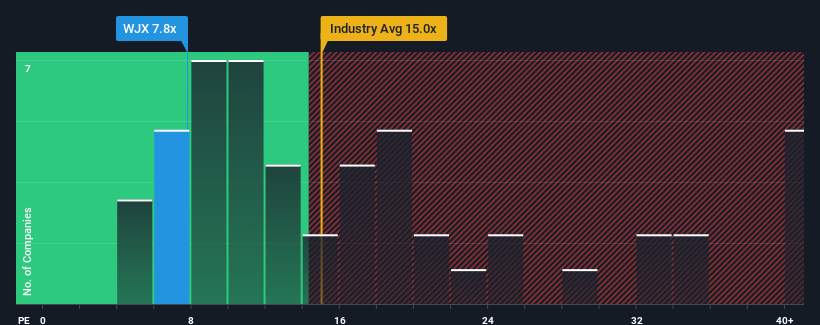- Canada
- /
- Trade Distributors
- /
- TSX:WJX
Wajax Corporation's (TSE:WJX) Subdued P/E Might Signal An Opportunity
With a price-to-earnings (or "P/E") ratio of 7.8x Wajax Corporation (TSE:WJX) may be sending bullish signals at the moment, given that almost half of all companies in Canada have P/E ratios greater than 14x and even P/E's higher than 31x are not unusual. Nonetheless, we'd need to dig a little deeper to determine if there is a rational basis for the reduced P/E.
Earnings have risen at a steady rate over the last year for Wajax, which is generally not a bad outcome. One possibility is that the P/E is low because investors think this good earnings growth might actually underperform the broader market in the near future. If you like the company, you'd be hoping this isn't the case so that you could potentially pick up some stock while it's out of favour.
See our latest analysis for Wajax

Is There Any Growth For Wajax?
In order to justify its P/E ratio, Wajax would need to produce sluggish growth that's trailing the market.
If we review the last year of earnings growth, the company posted a worthy increase of 5.5%. Pleasingly, EPS has also lifted 83% in aggregate from three years ago, partly thanks to the last 12 months of growth. So we can start by confirming that the company has done a great job of growing earnings over that time.
Weighing that recent medium-term earnings trajectory against the broader market's one-year forecast for expansion of 20% shows it's noticeably more attractive on an annualised basis.
With this information, we find it odd that Wajax is trading at a P/E lower than the market. Apparently some shareholders believe the recent performance has exceeded its limits and have been accepting significantly lower selling prices.
The Bottom Line On Wajax's P/E
While the price-to-earnings ratio shouldn't be the defining factor in whether you buy a stock or not, it's quite a capable barometer of earnings expectations.
We've established that Wajax currently trades on a much lower than expected P/E since its recent three-year growth is higher than the wider market forecast. When we see strong earnings with faster-than-market growth, we assume potential risks are what might be placing significant pressure on the P/E ratio. At least price risks look to be very low if recent medium-term earnings trends continue, but investors seem to think future earnings could see a lot of volatility.
You need to take note of risks, for example - Wajax has 2 warning signs (and 1 which can't be ignored) we think you should know about.
You might be able to find a better investment than Wajax. If you want a selection of possible candidates, check out this free list of interesting companies that trade on a low P/E (but have proven they can grow earnings).
Valuation is complex, but we're here to simplify it.
Discover if Wajax might be undervalued or overvalued with our detailed analysis, featuring fair value estimates, potential risks, dividends, insider trades, and its financial condition.
Access Free AnalysisHave feedback on this article? Concerned about the content? Get in touch with us directly. Alternatively, email editorial-team (at) simplywallst.com.
This article by Simply Wall St is general in nature. We provide commentary based on historical data and analyst forecasts only using an unbiased methodology and our articles are not intended to be financial advice. It does not constitute a recommendation to buy or sell any stock, and does not take account of your objectives, or your financial situation. We aim to bring you long-term focused analysis driven by fundamental data. Note that our analysis may not factor in the latest price-sensitive company announcements or qualitative material. Simply Wall St has no position in any stocks mentioned.
About TSX:WJX
Adequate balance sheet second-rate dividend payer.
Similar Companies
Market Insights
Community Narratives



